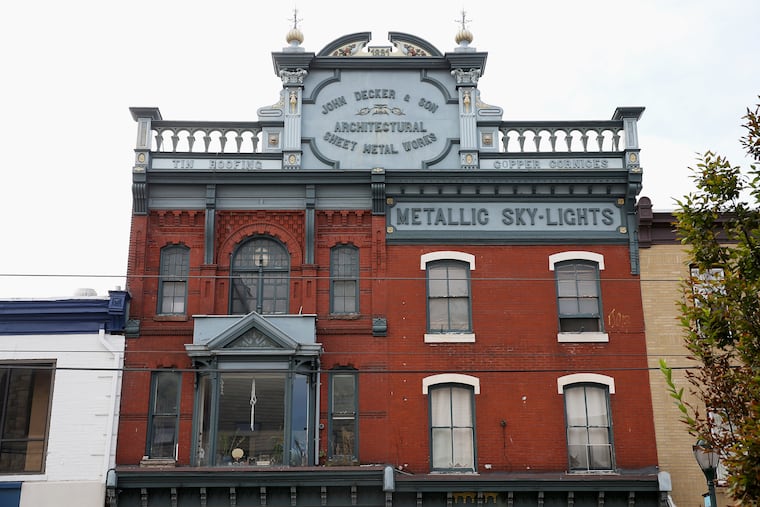Three decorative metal signs reveal the history of Philly’s Brewerytown neighborhood | Inga Saffron
For 19th century retailers and manufacturers, these big blaring signs were the equivalent of today's digital billboard.

A roof cornice is a decorative band that runs across the top of a building, drawing a line between structure and sky and, by implication, heaven and earth. Although today’s cornices tend to be purely functional things, architects once took pleasure in fashioning the cap into an elaborate work of art. Those decorative cornices became billboards that provided businesses with a convenient space for self-promotion. You could literally shout your name from the rooftops.
Few cornices in Philadelphia speak as loudly as the one atop the John Decker & Son Architectural Sheet Metal Works on Girard Avenue, near 27th Street. Completed in 1891, the pressed-tin crown was designed with the company’s name set in a central medallion, bracketed by fluted columns piled high with a dizzying array of classical details — Corinthian capitals, gold finials, lacy spires. In July, the Historical Commission recognized the blue-and-gold cornice as a city landmark and placed the building on the historic register.
Although John Decker gets top billing on the sign, the metal workshop was actually founded by his son, Theodore, according to a history prepared by Ben Leech for the Preservation Alliance. The elder Decker had immigrated to Philadelphia from Germany. He initially ran a hardware store on Callowhill Street but later moved his family to Brewerytown, then a German neighborhood. In 1874, Theodore began fabricating metal cornices for architects and building contractors in a small shop on Girard Avenue.
Theodore Decker’s timing was perfect. Philadelphia’s rapid industrial expansion had created a large middle class and a huge demand for housing. The Victorian styles then in fashion put a premium on decorative architectural features. Since carving stone by hand was expensive and time-consuming, builders began producing those details using cheaper materials.
Pressed tin and copper turned out to be an excellent substitute, especially for cornices. Not only could those metals be folded, shaped, and painted to look like stone, they were much lighter than the real thing. The introduction of new machinery for cutting metal also brought down the cost of fabrication, putting fancy trim within reach of middle-class homeowners. The faux stone cornices and columns were so popular that nearly 30 fabricators were operating around the city at the same time as Decker.
The enormous cornice on the Decker building essentially served as a company catalog and billboard rolled into one. The design enabled Decker to display its repertoire of classical forms. Also embossed on the pressed tin was a list of products and services. Although Leech wasn’t able to identify which cornices around the city were made by Decker, it seems likely that plenty of the work survives.
You can easily spot at least two similar cornice designs within a few blocks of Decker’s Brewerytown workshop. Although neither example reaches the same level of opulence, it certainly wouldn’t be surprising for the son of a German immigrant to find customers in the neighborhood, which was still more than half German in 1890.
The large metal cornice on the former Chas. A. Young & Co. soap factory building at 1242 N. 26th St. — a block north of Girard — has similar fluted columns bracketing its central medallion. Although the building, which was recently sold, now houses a repair garage, you can still make out the company’s name in faded letters. In researching the building’s history, preservationist Amy Lambert discovered that the soap company became famous in 1912 for being the first manufacturer to make a cross-country truck delivery, carrying a shipment of its borax soap to San Francisco.
Just a few blocks away, at 1440 N. 25th St., is another cornice with the telltale Decker signature. Now painted black, the cornice features columns of stacked geometric forms, bracketed by elegant fan-shaped motifs. They’re almost identical to the ones on the soap factory.
Even more interesting is the rowhouse-size building’s unusual form: It includes two identical corner storefronts, each propped up with a pole. The building is symmetrical and features cylindrical, second-floor bays at either end. Lambert, who has written several successful historic nominations, said she has never seen anything else like it in Philadelphia. She suspects the store was home to an early beer supplier called Stailey, which purchased barrels from one of Brewerytown’s many German breweries and bottled contents on its premises for retail sale. You can spot a loading dock on the Sharswood Street side of the building.
Building facades have always served as convenient advertising for merchants and manufacturers. Like the blazing digital screens that animate the new Fashion District in Center City, these artful cornices helped Philadelphia business promote their wares. The difference is that those signs hang from the facades. What makes the pressed-tin cornice signs produced by Decker and other fabricators so special is that these cornice billboards were fully integrated into the architecture.